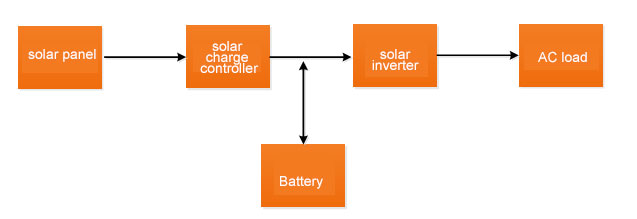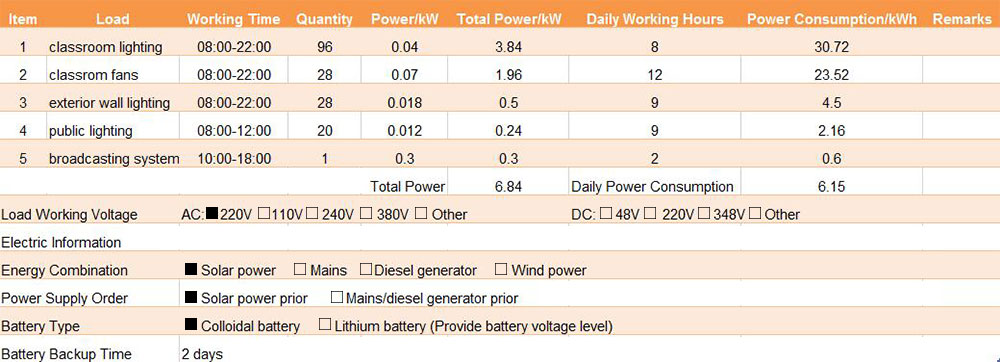Nowadays, there are still a large number of people living in impoverished or remote areas, which are far away from power plants and public power grids. Due to a shortage of power or even without power, they cannot enjoy the information and convenience brought by modern civilization. The off-grid solar power system is an independent self-sufficient renewable energy power supply system, which can resolve their basic power use demands.
A typical off-grid solar PV system is made up of six parts, including solar panels, the holder, a solar charge controller, an off-grid inverter, batteries, and a distribution box. The solar cells are connected to the solar charge controller, it produces the energy to first satisfy the user’s daily use, and then the superfluous power is stored in the batteries for use at night and during overcast and rainy days. When the power in the batteries is used up, a majority of inverters can support the input of the mains supply (or the diesel generator) as the supplementary energy source for the load.
The off-grid solar power system design is different from the grid-tie solar power system. The former needs to take into consideration many factors including the load, daily electricity quantity local climate conditions, and so on, to choose different design plans according to clients’ practical demands. Therefore, the off-grid solar photovoltaic system is comparatively complex.

Get to know your load power
In order to ensure the reliability of the off-grid PV system, a thorough survey of customer demands for electricity is very necessary. That is, you should figure out how much power you need, including the power ratings of all the appliances or devices, running time, and the daily electricity consumption (i.e. How many kilowatt-hours is it in total). After that, the design of the off-grid solar power system is mainly based on these data, including the solar inverter selection, solar panel capacity calculation, and battery capacity calculation.
Solar inverter selection
The power rating of the solar inverter to be selected should not be smaller than the total power of the loads. However, considering the lifespan and follow-up capacity expansion of the inverter, a certain margin of safety should be left for the inverter power, which is generally 1.2 to 1.5 folds as much as that of the load power. Besides, if the load includes sensitive appliances, such as the refrigerator, air-conditioner, water pump, and smoke exhaust ventilator with an electric motor (the startup power of the electric motor is 3 to 5 folds of its rated power), then the startup power of these load should also be taken into account. In other words, the startup power of these loads should be smaller than the maximum surge power of the inverter. Below is the formula for the solar inverter’s power selection, which is just for reference upon design.
Power of inverter = (Power of load × Margin factor)/ Power factor of inverter
Solar panel capacity calculation
The power generated by solar panel modules in the daytime is partly for load use, and the remaining is for charging the storage battery. When the night comes or when the solar radiation is inadequate, the electricity in the storage batteries will be discharged for load use. It can be seen that when there is no mains electricity during the day or the diesel engine is used as a supplementary energy source, the electricity consumed by the load comes from the electricity generated by the photovoltaic modules. Considering differences in illumination intensity in different seasons and in different regions, the capacity design of the solar panel should be capable of meeting demands even in the worst season of sunshine lighting so as to ensure the solar system’s reliable operation. Below is the formula for computing the solar panel capacity:
Power of solar panel = (Load daily electricity consumption × Margin factor)/ (Peak sunshine hours of worst month × Efficiency of the system)
Batteries capacity calculation
The batteries of the off-grid solar power system are mainly used to store energy and ensure that the load can work normally when the solar radiation is insufficient. In terms of the off-grid solar photovoltaic system for important equipment, the design of the battery capacity should take the number of local longest overcast and rainy days into consideration. The ordinary off-grid solar system does not have such a high requirement of power supply to the load and considering the cost of the system, the number of overcast and rainy days can be left unconsidered, and the load use can be adjusted according to the actual illumination intensity. In addition, most off-grid solar PV systems adopt lead-acid batteries, whose depth of discharge generally ranges from 0.5 to 0.7. The batteries’ capacity to be chosen can refer to the following formula:
Batteries' capacity = (Daily electricity consumption × Number of successive rainy and overcast days) / Batteries'depth of discharge
Solar charge controller selection
The solar charge controller is a device that manages the charging and discharging of the power from the solar panel to the batteries. The two key factors in selecting a suitable charge controller are rated voltage and current. The rated voltage of the charge controller is in line with the operating voltage of the batteries in the solar system. As for the current rating, it can be roughly calculated by the power from the solar panel divided by the voltage of batteries, and also reserve a margin of 25% for safety considerations.
In addition, there are two types of solar charge controllers in the market, PWM and MPPT. Generally speaking, PWM solar charge controllers are cheaper than MPPTs and are more suitable for small solar inverter systems. However, the MPPT solar charge controller is more cost-effective due to its unique advantages over the others. It can be selected based on a specific design plan.
A typical design plan for a 10kVA off-grid solar power system
Project background: To design an off-grid solar system for a school to satisfy its daily power consumption.
1. Survey on electricity demand. A survey of customer demands should be carried out in the early stage of the design plan. The information on load power consumption should be accurate. Below are more details:

2. Choosing solar inverter. The client’s load mainly includes classroom lighting, classroom fans, lighting of public places, wall lighting, broadcasting system, etc. The total load power is 6.84%kW and the solar inverter power should be no smaller than 9.8kVA. According to these requirements, the 10kVA solar inverter with MPPT charge controller can be selected, which plays the role of inverter and charge controller in one unit.
3. Calculating solar panel capacity. According to the client demand survey, the average daily electricity consumption of the school is around 61.5kWh. The local illumination conditions are favorable, it can calculate the daily duration of sunshine by 4.23h. The solar panel is configured with a 1.1-fold allowance. In this design, 88 pieces of 270W polycrystal photovoltaic modules are adopted with a total power of 23.76W and an average daily power generation of 100.5kWh. The system efficiency is generally around 0.8, so the daily electricity consumption is 80kWH.
4. Calculating battery capacity. The school’s lighting is usually during the night. Considering the batteries’ service life, the battery capacity should be properly increased, and the battery backup time should be two days as required by the client. The depth of discharge of the battery is set to 0.7. This project adopts the 110-node 1000AH/2V gel batteries in series, whose total capacity is around 220,000VAH, and the utilizable electricity quantity is around 154kWH, which can satisfy the power demand of two-day backup time.
The above is the design solution provided by Inverter.com, we hope it can be helpful to you.
